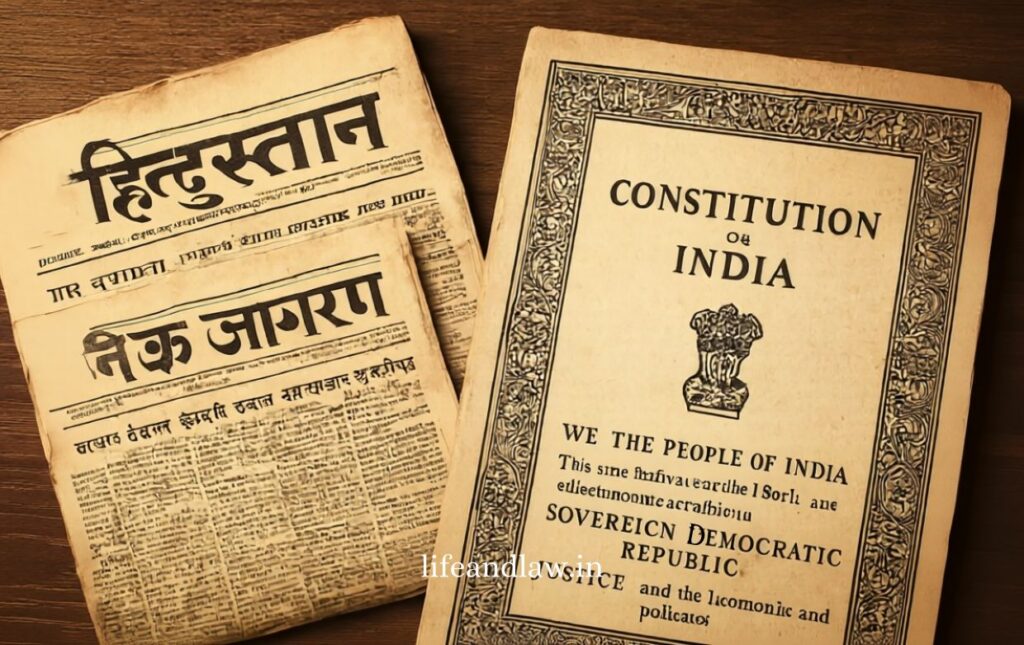Trending

Every year India commemorates Hindi Journalism Day in honour of Udant Martand, the first Hindi newspaper launched in 1826. This commemoration is more than just a tribute to journalism pioneers; it is also a celebration of the democratic values that the press protects. Hindi journalism, which is profoundly tied to the Constitution, serves as the people’s voice, while the Constitution remains the nation’s soul.
Journalism in India is about more than just reporting news; it also moulds public opinion, raises social awareness, and holds power accountable. The aim of this article is to emphasise the importance of free expression in the Constitution and how Hindi journalism has effectively used that freedom to preserve democracy.
Udant Martand (1826) founded Hindi journalism by voicing regular people’s concerns during British administration. Journalism evolved throughout time into both a weapon of the independence movement and a platform for social enlightenment.
Even before the Constitution went into effect, Hindi media promoted national identity and rights awareness among the people. It carried democratic concepts that constituted the basis for constitutional principles.
Journalism and the Constitution are inseparable and complimentary. If the Constitution is the heart of democracy, journalism is its voice.
Article 19(1)(a) of the Indian Constitution guarantees every citizen the right to free expression, allowing journalists to proclaim the truth, criticise governments, and inform the public. Journalism serves as a watchdog, questioning wrongdoing and holding governments accountable—earning its place as the fourth pillar of democracy.
However, the Constitution does entail responsibilities. It rejects misinformation, hate propaganda, and stuff that divides society. Journalism must consequently remain responsible, ethical, and truth-seeking. Courts have frequently stated that a free and independent press is the lifeblood of democracy.
In today’s digital age, where misinformation travels quickly on social media, journalism based on fundamental ideals is even more important. The press is more than just a legal institution; it is also an emotional and intellectual relationship that helps to sustain democracy.
The term “voice of the people” refers to Hindi journalism. It is more than just a news provider; it is a strong medium that expresses the masses’ feelings, struggles, and aspirations. With Hindi being the most frequently spoken language in India, particularly in rural areas, Hindi journalism connects directly with the average population. Since its founding, it has advocated for social awakening, educational reform, and liberation movement participation. It has always raised the voices of the marginalised, downtrodden, and disregarded.
When mainstream organisations miss concerns, Hindi journalism frequently brings them to light. It has used freedom of expression to criticise government policies, highlight social inequities, and sway public opinion towards reform.
Today, Hindi journalism exists on numerous platforms, including newspapers, television, websites, YouTube, and social media. It focuses on subjects that are often overlooked elsewhere, such as rural concerns, women’s safety, the environment, farmer protests, unemployment, and education. By emphasising these, Hindi journalism helps to improve democracy.
Despite its magnificent past, Hindi journalism suffers a few critical challenges:
• Political influence and pressures on editorial independence.
• Laws are being misused to muzzle journalists.
• Unchecked propagation of fake news and rumours across digital platforms.
• Financial challenges and limited resources, especially in rural journalism
These raise a key question: Does today’s media accurately reflect the spirit of the Constitution?
To protect the spiritual tie between Hindi journalism and the Constitution, various steps are necessary:
1. Young journalists should prioritise truth, ethics, and the public interest over profit or political influence.
2. Promoting media literacy helps citizens distinguish between facts and disinformation.
3. Independent Hindi media platforms require assistance and strengthening.
4. Strengthen legal protections for journalists and measures to ensure editorial freedom.
5. Hindi journalism must embrace modern technologies while maintaining its democratic responsibility of upholding constitutional ideals.
While commemorating Hindi Journalism, we must remember that the Constitution is the essence of our country, and journalism its voice. Every honest report, fair article, and rural narrative represents democratic principles and constitutional values. Protecting press freedom is not only a legal requirement, but also a moral obligation to preserve democracy.
This reflection is shared by Adv. Abdul Mulla in his legal articles on www.asmlegalservices.in and www.lifeandlaw.in, where he frequently discusses how law links with society and advances democratic values.
Adv. Abdul Mulla (Mob. No. 937 007 2022) is a seasoned legal professional with over 18 years of experience in advocacy, specializing in diverse areas of law, including Real Estate and Property Law, Matrimonial and Divorce Matters, Litigation and Dispute Resolution, and Will and Succession Planning. read more….
Copyright BlazeThemes. 2025